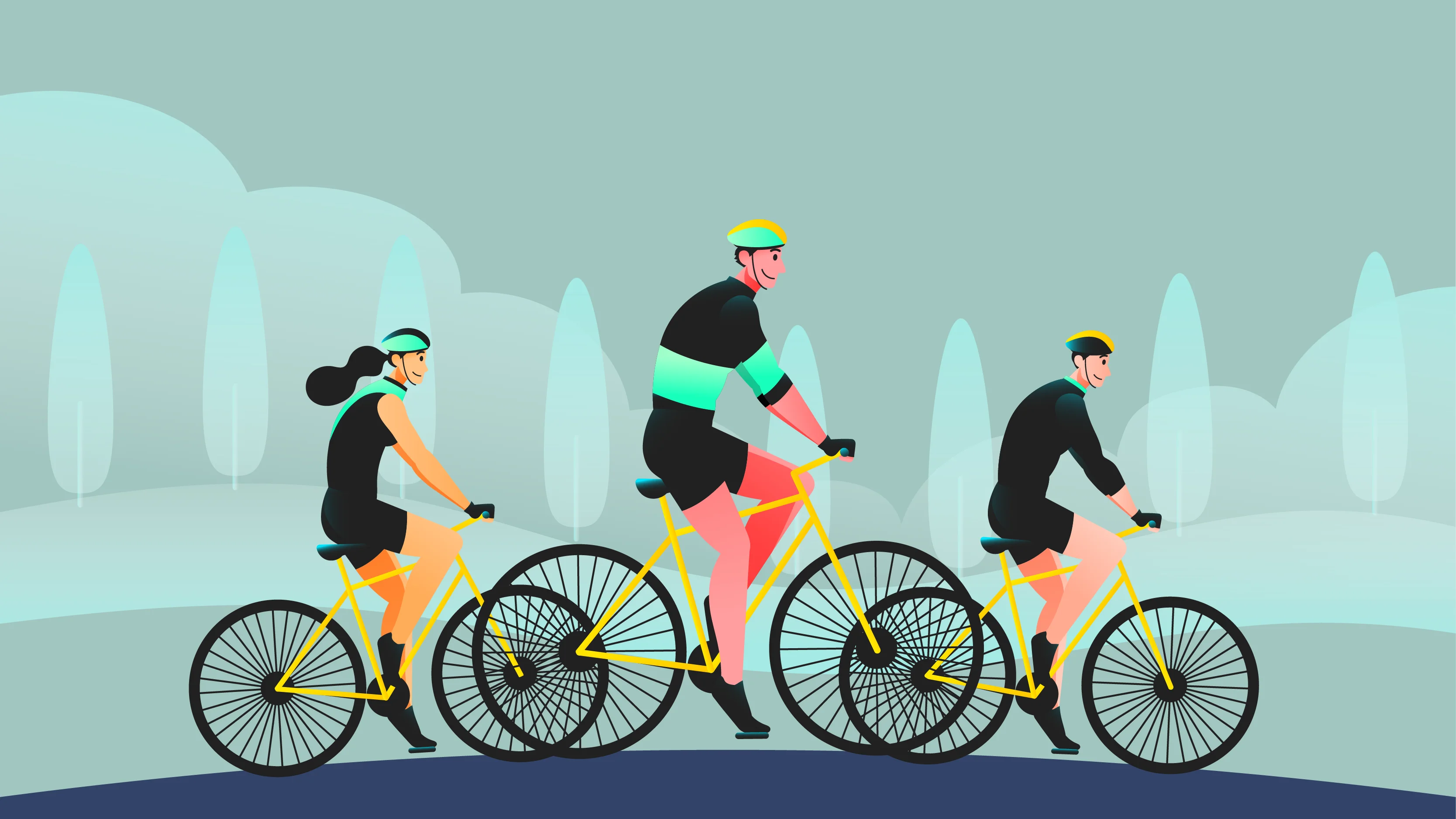
Introduction
Regular exercise is essential to the pursuit of a healthy lifestyle. Riding a bicycle is a great way to stay fit and healthy for people of all ages. It originated from nostalgic childhood rides and eco-conscious commuting. Riding a bike, whether indoors or on beautiful outside terrain, has a variety of benefits for cardiovascular health, muscular strength, weight management, and mental well-being.
Read More – How To Minimize Downtime During Your Workouts
Cycling is a low-impact exercise. Accepting cycling as a complete workout complements sustainable living and a joyful lifestyle while also improving personal health. Whether cycling outdoors or indoors on an exercise bike, this low-impact activity offers a range of advantages that contribute to cardiovascular fitness, muscle strength, weight management, and mental health.
This essay further examines the many advantages of cycling for overall health, taking into account both mental and physical factors.
Physical Benefits of Cycling
1. Cardiovescular Workout: Cycling is one of the best cardiovascular exercises since it requires the heart and lungs to work together efficiently to pump blood that is rich in oxygen to the muscles in the lower limbs. For people of all abilities, this aerobic exercise dramatically enhances cardiovascular health, endurance, and general fitness.
2. Muscle Engagement: Cycling engages key muscle groups—the quadriceps, calf muscles, glutes, hamstrings, and hip flexors. The dynamic pedal motion delivers a thorough lower-body workout, fostering muscle toning and strength development. This comprehensive engagement makes cycling an effective exercise for sculpting and strengthening various muscle regions in the lower body.
3. Muscle Building: Building muscle with cycling depends on several elements, including exercise frequency and resistance level. High-intensity, high-resistance workouts are necessary to achieve optimal muscle growth; these should preferably be done three to four times per week. The key to using cycling effectively for building muscle is to consistently perform demanding workouts that are customized to each person’s fitness objectives and preferences.
4. Weight Loss: Riding a bicycle is a powerful way to lose weight since it burns fat, especially on long rides. A well-balanced, calorie-conscious diet must be combined with frequent cycling to achieve successful and long-lasting weight loss. A healthy weight can be achieved and maintained with the help of this nutritional mindfulness combined with physical activity.
5. Low Impact Exercise: Cycling’s low-impact nature renders it gentle on joints, making it an ideal choice for beginners and those with knee or joint concerns. The capacity to customise resistance and seat height enhances its adaptability, ensuring a safe and comfortable exercise option that accommodates varying fitness levels and addresses specific health considerations.
Mental Benefits of Cyling
1. Mood Enhancement: Riding a bike has significant mental health advantages. It can improve mood in both indoor and outdoor settings, whether the ride is done in a rhythmic indoor class or not. Combining physical activity, music, and a concentrated environment has a beneficial effect on mental health. Riding a bike can be a fun and delightful way to improve one’s general mood and mental condition because of its rhythmic nature and immersive experience, which evoke feelings of joy and accomplishment.
2. Mental toughness: Cycling at a high intensity helps people develop mental toughness by making them face and overcome discomfort and exhaustion. Increased mental power is a result of the resilience that is built up amid these difficulties. Overcoming physical obstacles when riding a bike can provide a sense of confidence that carries over into other areas of life, leading to a stronger sense of self-worth and resilience. Cycling is becoming recognised as a potent way to strengthen mental toughness and experience a feeling of accomplishment in addition to being a physical activity.
3. Peaceful Escape: Riding a bicycle has a calming effect that extends beyond the physical world because of its rhythmic quality and symbiotic relationship with music. The contemplative sensation induced by the rhythmic pedal strokes enables people to detach from the pressures and stresses of everyday life. A calm sensation of peace arises as riders immerse themselves in the smooth symbiosis of body and bike. Riding a bicycle becomes a therapeutic release, a way to momentarily escape the hectic pace of daily obligations and stresses and find peace and renewal.
4. Cognitive Benefits: In addition to its physical benefits, cycling regularly has significant cognitive advantages. Research has connected riding to better cognitive function, which includes increased creativity, sharper thinking, and better remembering. Increased blood flow to the brain and the production of neurotrophic factors promote brain cell growth and maintenance, which is essential for mental health in general. Riding a bicycle, then, becomes a holistic activity that fosters not only physical fitness but also cognitive function and a holistic perspective on mental health and overall wellbeing.
Emotional and Social Health
1. Improved sleep quality: Regular exercise, like riding a bike, is linked to better sleep, which is essential for mental health. Riding a bicycle helps to improve sleep patterns, which in turn helps to control mood and emotional reactions. Since peaceful and restorative sleep is known to be a fundamental component of general health, including cycling in one’s routine can have a significant impact on one’s physical and emotional well-being.
2. Community Engagement: Cycling is a social activity that fosters community involvement in addition to being a form of individual fitness. Connecting with like-minded people might be facilitated by joining bike clubs, joining group rides, or attending events. These social exchanges foster a sense of community and belonging in addition to improving the bike experience.
3. Building friendships: Beyond only being a form of physical fitness, riding with friends or joining a group fosters a supportive social atmosphere. Traveling together fosters the development of new relationships in addition to strengthening current ones. Building lasting relationships while pursuing a shared interest in bikes is made more gratifying and pleasurable by the camaraderie that arises from riding.
4. Increased social confidence: Engaging with bicycle groups or activities may improve one’s social confidence. Establishing connections with like-minded folks is made easier by the common ground and conversation starters provided by a shared passion for riding. The social milieu that the group setting fosters encourages people to interact with one another and form relationships. Riding together fosters a deeper love of bicycling as well as a greater sense of social confidence in riders, which makes riding an empowering means of personal development and forming enduring relationships.
Conclusion
To sum up, adding cycling to your exercise regimen is a comprehensive way to enhance your general health. Cycling has many advantages, such as cardiovascular fitness, muscle development, weight control, and mental toughness, whether it is done indoors or outdoors. It’s a safe option for novices and people with joint difficulties because of its low-impact nature, which guarantees accessibility for people of all fitness levels. Cycling has many benefits for mental health in addition to physical ones.
Read More – Five Ways To Encourage Your Friends And Family To Join You In The Gym
It improves mood, builds mental toughness, and provides a peaceful diversion from the stresses of daily life. Its beneficial effects also extend to emotional and social domains, improving the quality of sleep, promoting community involvement, and cultivating enduring connections. Embracing cycling as a comprehensive workout aligns with a sustainable and joyful lifestyle, making it a valuable addition to a well-rounded approach to health and fitness.
Read More – Here’s How To Be More Efficient While Working Out



